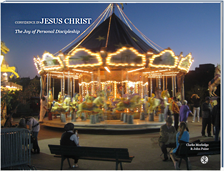I am taking a break from listening to the cicadas singing this May to publish another post about our Christmas in Europe….Our last morning in Cambridge, England, during our “Christmas-in-Europe” trip in late 2023 and early 2024, was spent attending Eden Church.
One of the coolest surprises about visiting Eden Church was getting to meet a Christian scholar and author whom I have greatly respected over the years. My wife and I were sitting with our friends, Jon and Meredith Thompson, and their family (Jon is the executive director of the Cambridge House at the College of William and Mary). Two rows ahead of us, I saw a man whose hair on the back of his head looked very, very familiar. I asked Jon, “Is that Simon Gathercole two rows in front of us?”
“Why, yes, it is,” replied Jon. After the service, I made my way up to meet Simon Gathercole, a scholar of the New Testament and Early Christianity. Simon Gathercole is simply a great guy to meet, very friendly and not what one thinks of as a nerdy Bible scholar. Though confessionally an evangelical, Simon Gathercole’s research is highly respected across a wide theological spectrum, one of the tops in his field. We chatted about some of the books he has written and/or contributed to over the years.

Veracity blogger (me!!) with Simon J. Gathercole. United Kingdom New Testament scholar, Professor of New Testament and Early Christianity, and Director of Studies at Fitzwilliam College, Cambridge.
My first encounter with Dr. Gathercole’s work was from a co-edited volume of the book, How God Became Jesus, a response to Bart Ehrman’s book of a similar title, How Jesus Became God. The book was reviewed here on Veracity back in 2014, ten years ago. Simon Gathercole wrote a chapter defending the idea that the Gospels really do make claims regarding the divinity of Jesus, in contrast to Ehrman’s claim that the theology of Jesus’ divinity emerged later in the history of the early church. Here is a sample of what Gathercole writes:
“Ehrman’s argument that the Jesus of Matthew, Mark, and Luke is a Jesus fundamentally different from the later preexistent, divine Jesus of the creeds is a flawed one. For one thing, preexistence is more deeply rooted in the Gospels than Ehrman recognizes (although, to be fair, most other commentators on the Gospels also underestimate its significance). More importantly, a divine identity is attributed to Jesus in the Gospels, and not merely a divine identity of a low-level kind” (p.102).
This is just a teaser, as the whole essay is remarkable. I highly recommend the book, and particularly Gathercole’s essay in it. I have a few other books written by Simon Gathercole on my “to-be-read” list, which I look forward to diving into at some point. It was such a pleasure to meet and converse with such as world-class Bible scholar!!
A final note…. if you like podcasts, and would like to hear Simon Gathercole speak, he was recently interviewed on John Dickson’s Undeceptions podcast, where he discusses the popular claim, advanced by skeptics like Bart Ehrman, that the four Gospels were completely anonymous, and so we have no idea who wrote them. Simon Gathercole takes a different view. Check it out!




















